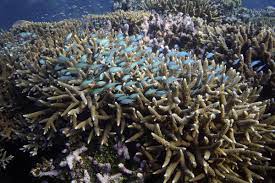Today Current Affairs: 30th November 2022 for UPSC IAS exams, State PSC exams, SSC CGL, State SSC, RRB, Railways, Banking Exam & IBPS, etc
Table of Contents
Red Planet Day 2022:

On November 28, 1964, the NASA mission Mariner 4 was launched, which ended up capturing significant information on, and photographs of, Mars for the first time thus marking Red Planet Day.
Mars:
- It is the fourth planet from the Sun and the second-smallest planet in the Solar System.
- Mars is about half the size of Earth.
As Mars orbits the Sun, it completes one rotation every 24.6 hours, which is very similar to one day on Earth (23.9 hours). - Mars’ axis of rotation is tilted 25 degrees with respect to the plane of its orbit around the Sun.
- This is similar to Earth, which has an axial tilt of 23.4 degrees.
- Mars has distinct seasons like Earth, but they last longer than seasons on Earth.
- Martian days are called sols—short for ‘solar day’.
- The reason Mars looks reddish is due to oxidation or rusting of iron in the rocks, and dust of Mars. Hence it is also called the Red Planet.
- It has the largest volcano in the solar system i.e., Olympus Mons.
- It has two small moons, Phobos and Deimos.
Himalayan Yak : Approved As Food Animal

The Food Safety and Standard Authority of India (FSSAI) has approved the Himalayan Yak as a ‘food animal’.
- The move is expected to help check decline in the population of the high-altitude bovine animal by making it a part of the conventional milk and meat industry.
- Food Animals are those that are raised and used for food production or consumption by humans.
Himalayan Yak:
- The Yak belongs to the Bovini tribe, which also includes bison, buffaloes, and cattle. It can tolerate temperatures as low as-40 degrees Celsius.
- Adapted for living at high altitudes, they have long hair that hangs off their sides like a curtain, sometimes touching the ground.
- Yaks are highly valued by Himalayan peoples. According to Tibetan legend, the first yaks were domesticated by Tibetan Buddhism founder Guru Rinpoche.
- They are also known as the lifeline of pastoral nomads in high altitudes of the Indian Himalayan region.
- Yaks are traditionally reared under a transhumance system which is primitive, unorganised and full of hardship.
- They are endemic to the Tibetan Plateau and the adjacent high-altitude regions.
- Yaks are most comfortable above 14,000 feet.
- They climb to an elevation of 20,000 feet when foraging and usually don’t descend any lower than 12,000 feet.
- The yak-rearing states of India are Arunachal Pradesh, Sikkim, Uttarakhand, Himachal Pradesh and Jammu & Kashmir.
Five New Species Of Black Corals:

Some researchers have discovered five new species of Black Corals living as deep as 2,500 feet (762 metres) below the surface in the Great Barrier Reef and Coral Sea off the coast of Australia.
- Black corals (Anthozoa: Antipatharia) can be found growing both in shallow waters and down to depths of over 26,000 feet (8,000 metres), and some individual corals can live for over 4,000 years.
- However, the taxonomy of black corals is poorly known compared to many other anthozoan groups
- Many of these corals are branched and look like feathers, fans or bushes, while others are straight like a whip.
- Unlike their colourful, shallow-water cousins that rely on the sun and photosynthesis for energy, black corals are filter feeders and eat tiny zooplankton that are abundant in deep waters.
- Similarly, to shallow-water corals that build colourful reefs full of fish, black corals act as important habitats where fish and invertebrates feed and hide from predators in what is otherwise a mostly barren sea floor. For example, a single black coral colony researchers collected in 2005 off the coast of California, United States, was home to 2,554 individual invertebrates.
Coral Reefs:
- Corals are marine invertebrates or animals which do not possess a spine. In scientific classification, corals fall under the phylum Cnidaria and the class Anthozoa.
- Coral is made up of genetically identical organisms called polyps.
- These polyps have microscopic algae called zooxanthellae living within their tissues.
4th India-France Defense Dialogue:

The 4th India-France Defense Dialogue was held in India.
Key Highlights:
- Both countries discussed Defence Industrial Cooperation with a focus on ‘Make in India’.
- A wide range of bilateral, regional and defence industrial cooperation issues were discussed during the dialogue.
- Both sides reviewed the ongoing military-to-military cooperation, which has increased substantially in recent years.
- They recognised their convergences on a number of “strategic and defence issues and shared the commitment to work together on enhancing cooperation in bilateral, regional and multilateral fora, with a focus on the Indo-Pacific region.
- The discussions ranged from enhancing cooperation in areas of mutual interest to the maritime challenges in the IOR (Indian Ocean Region).
- France reaffirmed its engagement in the Indo-Pacific and India’s centrality in the French strategy for the region.
- France is the current chair of Indian Ocean Commission (IOC) and Indian Ocean Naval Symposium (IONS) and both countries cooperate closely in these fora.
Nai Chetna-Pahal Badlav Ki Campaign:

The Ministry of Urban Development launches the “Nai Chetna-Pahal Badlav Ki”- A Community-led National Campaign Against Gender-Based Discrimination.
- Kerala also launched the campaign under the umbrella of the Kudumbashree Mission.
- Nai Chetna-Pahal Badlav Ki Campaign is a four-week campaign, aiming at equipping women to recognise and prevent violence and making them aware of their rights.
- Activities will be centred on the theme of ‘Gender equality and gender-based violence.’
- This will be an annual campaign focussing on specific gender issues each year.
- The focus area of the campaign this year is gender-based violence.
- This campaign will be implemented by all states in collaboration with Civil Society Organisations (CSO) partners, and actively executed by all levels including the states, districts and blocks, engaging the community institutions along with the extended community.
- The campaign will bring together all line departments and stakeholders to create a concerted effort in acknowledging, identifying and addressing the issues of violence.
State Of The Climate In Asia 2021:

The State of the Climate in Asia 2021 report was published by the World Meteorological Organization and the UN Economic and Social Commission for Asia and the Pacific (ESCAP).
Findings of the Report:
- Floods and storms accounted for 80% of the natural disasters that struck Asia in 2021.
- Asian countries incurred financial losses worth USD 35.6 billion in 2021 because of natural disasters.
- Flooding was the event with “by far the greatest impact in Asia in terms of fatalities and economic damage.”
- This showed that the economic impact of such disasters is on the rise compared to the average of the last twenty years.
- India suffered a total loss of USD 3.2 billion from flooding and the country faced heavy rains and flash floods during the monsoon season between June and September 2021.
- These events resulted in about 1,300 casualties and damaged crops and properties.
- The country was only second to China in the Asian continent in this regard.
- Similarly, storms also caused significant economic damage, especially in India (USD 4.4 billion), followed by China (USD 3 billion) and Japan (USD 2 billion).
- During 2021, India experienced five cyclonic storms (Tauktae, Yaas, Gulab, Shaheen, Jawad) with maximum sustained wind speeds of ≥ 34 knots.
- Additionally, in 2021, thunderstorms and lightning claimed around 800 lives in different parts of the country.
Seventh Edition Of The Global Technology Summit:

The seventh edition of the Global Technology Summit will be held from November 29, 2022 till the 1st of December in New Delhi in a hybrid format.
- The Summit is India’s annual flagship event on Geotechnology and is co-hosted by the Ministry of External Affairs and Carnegie India.
- The theme for this year’s Summit is ‘Geopolitics of Technology’.
- During the summit, the world’s leading minds in technology, government, security, space, startups, data, law, public health, climate change, academics, economy will gather and debate the vital questions related to technology and its future.
- They will discuss the advantages and challenges of technologies, sustainability, emerging geopolitics in the technology sector, and data for development and ideas for India’s G20 Presidency.
India’s First Private Space Vehicle Launchpad:

Agnikul Cosmos sets up India’s first private space vehicle launchpad at Sriharikota.
- The facility, which was designed by Agnikul and executed in support with ISRO and IN-SPACe (Indian National Space Promotion and Authorization Center) has two sections to it:
- the Agnikul launchpad (ALP) and
- the Agnikul mission control center (AMCC).
- All critical systems connecting these two sections, which are 4 km away from each other, are redundant to ensure 100% operationality during countdown.
- The launchpad is specifically built keeping in mind the necessity to support liquid stage controlled launches, while also addressing the need for ISRO’s range operations team to monitor key flight safety parameters during launches.
- Additionally, it has the ability to, as necessary, share data and other critical information with ISRO’s Mission Control Center.
- Agnikul’s first launch, which will be a controlled and guided mission, a vertical launch, using its patented engine will happen from this launchpad.
- The mission will be a technology demonstrator that will mirror Agnikul’s orbital launch but at a reduced scale.
Harike Wetland : Arrival Of Migratory Birds

Migratory birds from different countries have started arriving at Punjab’s Harike wetland
- Harike wetland, spread over 86 square kilometers in Tarn Taran, Ferozepur, and Kapurthala districts, serves as a home to rare species of migratory water birds during the winter season.
- Harike Wetland also known as “Hari-ke-Pattan”, with the Harike Lake in the deeper part of it, is the largest wetland in northern India.
- The wetland and the lake were formed by constructing the headworks across the Sutlej river in 1953.
- The headworks is located downstream of the confluence of the Beas and Sutlej rivers just south of Harike village.
- It has been designated as one of the Ramsar sites in India.
- Apart from the Harike wetland, migratory water birds also arrive at Keshopur Miani wetland, Nangal wetland, Ropar wetland, Kanjli wetland and Beas river wetland in Punjab.
Shiveluch Volcano : Russia

According to Scientists, the Shiveluch volcano in Russia’s far eastern Kamchatka peninsula may be gearing up for its first powerful eruption in 15 years.
- Shiveluch is one of the largest and most active volcanoes in Kamchatka, having erupted at least 60 times in the past 10,000 years.
- It has two main parts:
- Old Shiveluch, which tops 3,283 metres (10,771 ft), and
- Young Shiveluch – a smaller, 2,800-metre peak protruding from its side.
- Young Shiveluch lies within an ancient caldera – a large crater-like basin that likely formed when the older part underwent a catastrophic eruption at least 10,000 years ago.
- The volcano has been continuously erupting since August 1999, but occasionally undergoes powerful explosive events, including in 2007.
- Kamchatka is home to 29 active volcanoes, part of a vast belt of Earth known as the “Ring of Fire” which circles the Pacific Ocean and is prone to eruptions and frequent earthquakes.




